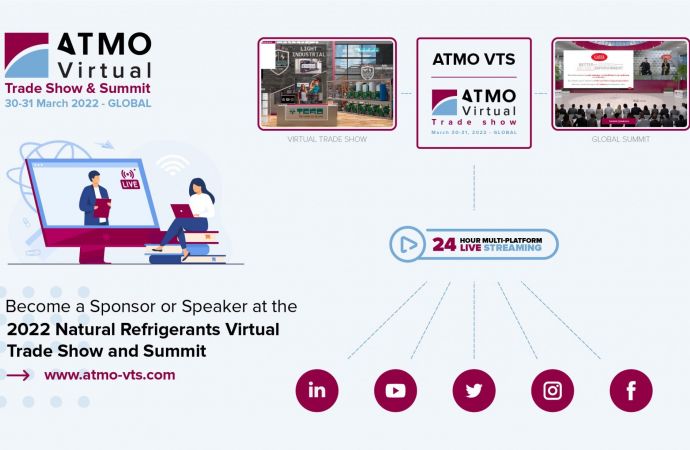Speakers representing airports, buildings and food processing share experiences with pay-for-service model at CaaS E-Summit.

The panel who shared end user perspectives during the global CaaS E-Summit in December last year.
Implementers of the cooling-as-a-service (CaaS) business model in both the real estate and food processing sectors, as well as representatives from airport and building trade groups, testified to the cost savings in energy and maintenance made possible by CaaS at the CaaS E-Summit in December.
Cooling-as-a-service is a business model by which end users affordably pay for sustainable cooling systems on a pay-for-service model, without the burden of making large up-front CAPEX investments. It is particularly helpful in the developing world; other examples shared at the CaaS Summit can be found here.
The CaaS E-Summit was organized and hosted by Switzerland-based Basel Agency for Sustainable Energy (BASE). BASE, along with the Kigali Cooling Efficiency Program (K-CEP), manages the CaaS Initiative, which has been working on contracts, pricing models marketing material and events to support the implementation of CaaS projects. (shecco, publisher of this website, is a supporting partner of Cooling as a Service Initiative.)
Overall the message from end users at the CaaS E-Summit was that CaaS has enabled them to leapfrog to more sustainable cooling technologies while removing the hassle of maintaining the cooling equipment in-house, thereby allowing them to focus on their core activities. It has also unlocked considerable savings in terms of energy savings and reduced maintenance costs.
Rafael Echevarne, Director General of the Airports Council International – Latin America and the Caribbean (ACI-LAC), spoke around CaaS as a solution for airports. In a tropical region, cooling is very important for an airport, comprising almost 25% of costs, he explained. With improvements of equipment efficiency, huge savings can be achieved. However, this equipment is often too expensive upfront.
“Cooling as a Service is a game-changer for us – particularly in terms of cost,” said Echevarne.
Dominika Czerwinska, Director of Membership and Regional Networks from the World Green Building Council, said CaaS accelerates buildings’ path to net-zero emissions, removing barriers.
“The solutions that we put forward have to not only deliver in terms of efficiency and reducing carbon, but also in helping to remove some of those existing barriers that are slowing the transition of our industry to these solutions,” she said. “This is exactly why solutions like CaaS and the servitization of buildings is so important in helping us achieve those goals.”
Also present was Andrea Fernández, Engineering Manager of Grupo Gentor in Mexico, who shared her perspective as a building developer currently implementing CaaS. “The greatest benefit of CaaS is that it gives the end user access to high quality services, there are no upfront costs, and the maintenance and operation is outsourced – removing headaches for the end user,” explained Fernández.
Fernández is confident about scalability of the CaaS model and about the benefits for the end user and the investor, as well as the environment and community. “We will be advocating, at every opportunity we have, to supply the Cooling as a Service model,” she said.
André Snyman, General Manager of South African food processor Lynca Meats spoke about his experience with CaaS. By outsourcing its steam and cooling needs, Lynca realized “massive” energy and other cost savings, without having to acquire specialized skills in-house or spending capital upfront. “Still today it is a challenge to find the skills to run these plants and give you the ability to grow your company” said Snyman; “[CaaS] allowed us to focus and grow on our core business, with savings close to half a million Rand [US$32,747] a year; the plant is actually much more effective than initially thought.”
The question-and-answer period, facilitated by shecco CEO Marc Chasserot, addressed end user benefits of CaaS vs. Energy Performance Contracting (EPC) or Cooling Equipment Leasing, and whether other models were considered before selecting CaaS.
Fernández explained that Grupo Gentor did consider other options but selected CaaS because it removes all the financial risk for end users while also enabling the supply of the latest and most efficient cooling service.
Furthermore, in EPC contracts, savings related to consumption are subject to negotiations at periodic intervals between the technology supplier and the end user; this often leads to hurdles in customer relationships. This is not present in CaaS, where the end user knows in advance how much is charged per consumption.
Snyman added that CaaS offers more guarantees than other leasing options and allows end users to buy cooling in the most efficient way. It also gives the right incentives to solution providers to implement the most energy-efficient system as they cover all operation costs, including the electricity and water, he said.
Read a highlights package of the entire CaaS E-Summit
All E-Summit Videos Available Online
With 1,141 registrations from 82 countries, 50 speakers, and more than 16 hours of content, the CaaS E-Summit on December 1 gave a comprehensive look into the servitization landscape.
The digital platform will stay online as a virtual library for one year. Registrants can simply log back into the event and watch whichever session they choose. It is also possible to register post-event; new participants can use the code “CaaS!” to access the platform.
Related stories



